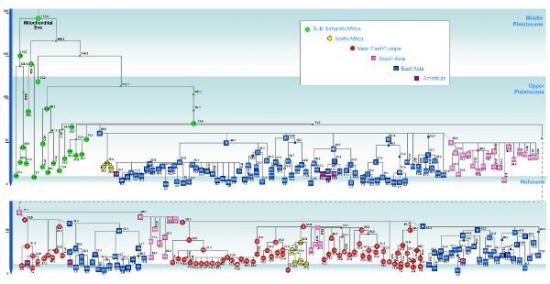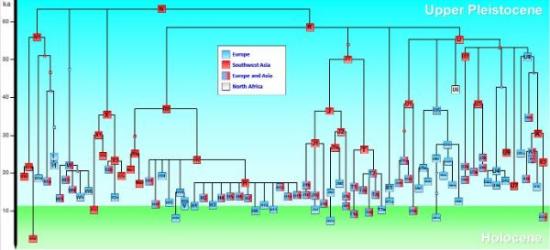University of Huddersfield
Source - http://www.hud.ac.uk/research/researchcentres/targ/

A new chronology for the human mtDNA tree. Branch lengths were estimated using maximum likelihood and the time-dependent molecular clock. Ages are expressed in kya. (See Soares et al. 2009)
The Archaeogenetics Group studies the geographic distribution of modern human genetic variation, with the aim of addressing questions from archaeology, anthropology and history. We do this primarily by combining the phylogenetic relationships between the lineages with their geographic distribution and diversity converted to time depth using the molecular clock, an approach termed ‘phylogeography’. Our main target until recently has been mitochondrial DNA (mtDNA), which is inherited without recombination down the female line of descent, allowing us to make inferences from estimates of the human maternal genealogy. We are increasingly also applying the phylogeographic approach to Y-chromosome variation, which traces the male line of descent, and are beginning to also study variation in the X chromosome and the autosomes.
One main avenue of research in the past few years, funded by the British Academy and the Bradshaw Foundation and more recently by FCT, has been the prehistory of Southeast Asia and the Pacific islands. In order to do this we had first to re-calibrate the mutation rate of the mtDNA molecular clock, and correct for the effects of natural selection (see calculator below). Our findings have challenged the consensus view of archaeologists and linguists concerning the history of the region, in which expanding farming communities from South China and Taiwan play the major role. This work, focused primarily on mtDNA, paralleled our earlier research in the 1990s on the prehistory of Europe, where we showed that the demographic contribution of pre-farming hunter-gatherer populations to the modern-day gene pool had been under-estimated in the past. We are also working on Y-chromosome and autosomal variation in Southeast Asia and the Pacific, attempting to map out in detail the dispersals that contributed to the formation of modern Southeast Asian populations. See:

Schematic phylogenetic tree of human mtDNA haplogroups in Europe, Southwest Asia and North Africa. The timescale is based on ML estimates and a time-dependent complete mtDNA genome clock. Haplogroups colour-coded according to their region of origin. (See Soares et al. 2010) Click the image to view full size
Our work on west Eurasia has continued and accelerated again in the last few years, with an active collaboration between ourselves and archaeologists, exemplifying the group’s philosophy of a harmonious marriage between archaeology and genetics. With a particular focus on the Near East, we have been aiming to test our earlier conclusions using the greater resolving power of complete mtDNA sequences. This work is funded by the Leverhulme Trust and the FCT, and our most recent results can be previewed here:
We have also worked with prehistorians on the reconstruction of human dispersals in Africa, and with historians on the genetic consequences of slavery. In research published in 2005 in the journal Science, funded by the Royal Society and the Discovery Channel, we focused on the process of the initial dispersal of modern humans out of Africa and the peopling of the world, proposing that humans dispersed primarily along the “southern coastal route” along the coastlines of the Red Sea and the India Ocean and on into Southeast Asia and Australasia. With funding from the Bradshaw Foundation, FCT and the Leverhulme Trust, we have continued to the details of the dispersal process, including the possible role of the eruption of the super-volcano Toba about 75,000 years ago. You can read about the Leverhulme award in the Trust’s newsletter (April 2012, p.8):
Our most recent results are previewed here.
Finally, we have been intermittently involved with ancient DNA (aDNA) research, including the mitochondrial genome of the Tyrolean Iceman, and are now beginning in earnest with a new facility at Huddersfield run by Dr Paul Brotherton.
e.g. http://news.nationalgeographic.com/news/2008/10/081030-iceman-DNA.html